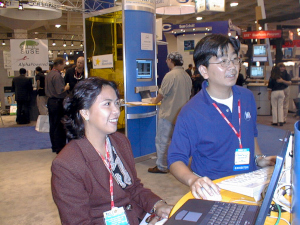 Co-founded International Messaging Associates (IMA), a multi-national networking software company specializing in corporate electronic messaging solutions. Served as Managing Director responsible for market research, product development (engineering, technical support and test engineering), technical writing and daily operations (Philippines). Acted as chief architect for the Internet Exchange Messaging Server, a corporate server email platform. Guided the company through a successful private funding placement in 1999.
Co-founded International Messaging Associates (IMA), a multi-national networking software company specializing in corporate electronic messaging solutions. Served as Managing Director responsible for market research, product development (engineering, technical support and test engineering), technical writing and daily operations (Philippines). Acted as chief architect for the Internet Exchange Messaging Server, a corporate server email platform. Guided the company through a successful private funding placement in 1999.
Established in 1993 in the San Francisco Bay Area, we moved the company to Hong Kong in May 1994 with Philippine operations established in December 1997. Initially financed with personal funds, the company grew through product sales for the first several years. It eventually reached USD 3M per year and staffing to between 70 and 80 staff across the two offices during this time. Staff turnover was almost non-existent. In 1999, we received our only external funding and used it to expand operations at both locations.
Prior to starting IMA I had spent several years working for Silicon Valley UNIX and Networking startup companies. I had briefly started a company, which while it was not successful was a valuable learning experience for what was to come later. I also spent several years doing applied research and development in the areas of electronic mail and related technologies for the US government. This included standards related work with the OSI Implementors Workgroup (NIST), IFIP Working Group 6.5 (X.400/X.500), and periphery involvement with the IETF MIME standards work. These combined experiences provided a unique perspective to markets and technologies as they relate to electronic messaging – which was critical in the establishment of IMA.
International Messaging Associates Website (Archive)
Commitment to Quality
 IMA’s customers ranged from large corporate and government organizations to small businesses and included the US Senate, IRS, White House, US Navy, United Nations, The Red Cross, Financial Times, Morgan Stanley, Lehman Brothers, Minolta, Sony, and many others. As a provider of mission critical messaging solutions, stability, ease of use, and being responsive to the needs of our customers was essential. While we did have some growing pains in this area, the quality and stability of our solutions set us apart from the competition. This commitment to quality and the lowest possible defect rate was evident in not only our procedures but in how we structured the company.
IMA’s customers ranged from large corporate and government organizations to small businesses and included the US Senate, IRS, White House, US Navy, United Nations, The Red Cross, Financial Times, Morgan Stanley, Lehman Brothers, Minolta, Sony, and many others. As a provider of mission critical messaging solutions, stability, ease of use, and being responsive to the needs of our customers was essential. While we did have some growing pains in this area, the quality and stability of our solutions set us apart from the competition. This commitment to quality and the lowest possible defect rate was evident in not only our procedures but in how we structured the company.
Gateway Products
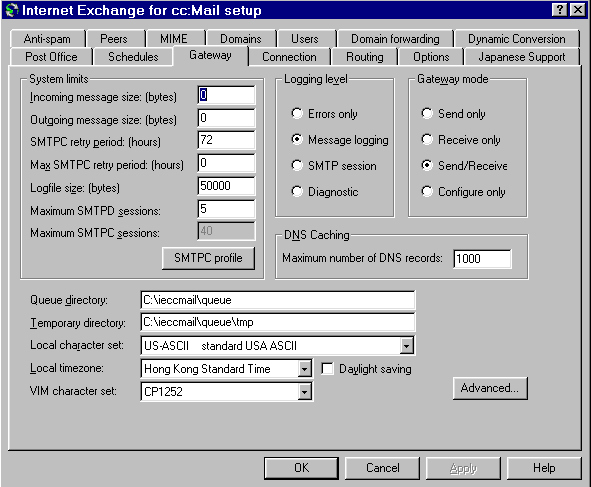 When we established IMA, the commercial use of the Internet was just beginning. The web was just getting off the ground. Internet-based email primarily served educational and government users connected to the ARPANET/MILNET. Companies who used electronic mail did so mainly within their own groups using PC network applications such as cc:Mail (the market leader) and later Lotus Notes. The Internet Exchange gateway solutions provided a standards based connection between these legacy email islands and the global Internet. The gateway products ran under Microsoft Windows. Initially this was Windows 3.1 but over the years support for more modern platforms was provided as the newer operating systems became available.
When we established IMA, the commercial use of the Internet was just beginning. The web was just getting off the ground. Internet-based email primarily served educational and government users connected to the ARPANET/MILNET. Companies who used electronic mail did so mainly within their own groups using PC network applications such as cc:Mail (the market leader) and later Lotus Notes. The Internet Exchange gateway solutions provided a standards based connection between these legacy email islands and the global Internet. The gateway products ran under Microsoft Windows. Initially this was Windows 3.1 but over the years support for more modern platforms was provided as the newer operating systems became available.
Internet Exchange acts as a bridge between either a cc:Mail Post Office or a Lotus Notes Server and the Internet (or any TCP/IP network). Electronic mail exchanged between cc:Mail and Notes environments is converted into formats understood on the Internet. In the other direction, the opposite conversion takes place. This conversion process is transparent to end users on both sides of the gateway. cc:Mail and Notes users appear as Internet users on the Internet side of the gateway, and Internet users appear as either cc:Mail or Notes users in the cc:Mail or Notes environments. This provides a non-intrusive way to integrate Internet messaging into existing LAN email environments.
Messaging Server
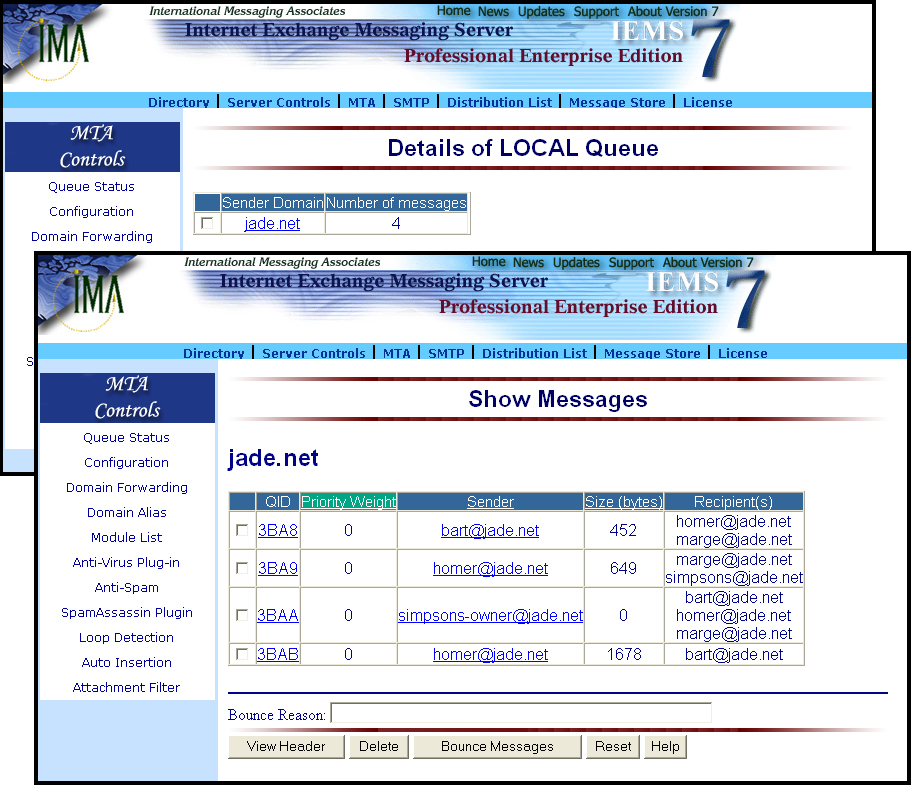 The Internet Exchange Messaging Server (IEMS) is a highly modular and scalable open architecture messaging solution. The system could be installed on a small single machine or a fully distributed configuration linking geographically distributed sites. IEMS integrated several different modules including the Message Transfer Agent (MTA), Distribution List Manager, Message Store, Directory Server, and others. The main server process, the responder controlled all IEMS modules (starting, stopping, monitoring). IEMS Input Channels receive new messages, and IEMS Output Channels send them to their next destination. Foreign system connectors for cc:Mail and Lotus Notes ensured seamless legacy system integration.
The Internet Exchange Messaging Server (IEMS) is a highly modular and scalable open architecture messaging solution. The system could be installed on a small single machine or a fully distributed configuration linking geographically distributed sites. IEMS integrated several different modules including the Message Transfer Agent (MTA), Distribution List Manager, Message Store, Directory Server, and others. The main server process, the responder controlled all IEMS modules (starting, stopping, monitoring). IEMS Input Channels receive new messages, and IEMS Output Channels send them to their next destination. Foreign system connectors for cc:Mail and Lotus Notes ensured seamless legacy system integration.
IEMS 7 introduced a new integrated Anti-Spam approach to message reception and delivery. The MTA Pass-Through technology allowed end users (message store accounts), individual distribution list maintainers, and connector modules to define their own security profiles independent of the rest of the system. At the same time, the messaging system administrator could still set an overall global security policy, where the MTA directly managed some anti-spam measures, such as traffic identified by reliable DNS-BLs. The administrator could then pass other measures, like DNS-BLs with known high false-positive rates, to users for consultation on a case-by-case basis, if desired by part of the user community.
The Internet Exchange Messaging Server ran under Microsoft Windows and many Linux distributions. Legacy connectors for cc:Mail and Lotus Notes required a Windows machine but worked fine in a distributed IEMS network with other modules such as the MTA running Linux. Server maintenance was performed using the built-in IEMS web interfaces.
Company Operations

IMA based its main office in Hong Kong, where the team managed lead engineering, primary finance, shipping, printing, and some sales activities. The company set up a second engineering group in the Philippine office, which collaborated with their Hong Kong counterparts. The Philippine office also managed technical support (including call center operations), test engineering, marketing, and writing (technical, marketing, and sales). IMA established an international sales representative network in the United States, United Kingdom, and Germany, while the company directly handled other regions through one of its offices. I managed all Philippine operations in addition to directing the engineering efforts across both offices.
Engineering
 The Hong Kong engineering group led all gateway product design. With the expansion of the IEMS product line, overall system architecture and protocol work remained in Hong Kong, although the Philippine group had a large say in how the architecture evolved. The Philippine engineering group led most UI and system related module design. Engineering groups in both locations worked very closely with the technical support, test engineering, and technical writing groups.
The Hong Kong engineering group led all gateway product design. With the expansion of the IEMS product line, overall system architecture and protocol work remained in Hong Kong, although the Philippine group had a large say in how the architecture evolved. The Philippine engineering group led most UI and system related module design. Engineering groups in both locations worked very closely with the technical support, test engineering, and technical writing groups.
Test Engineering and Technical Support
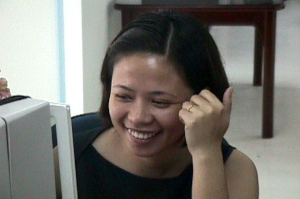 By their very nature, IMA products were highly technical. Our customers and primary contacts were senior network administrators. We were building cutting edge messaging solutions with features and options not found in other products. This created both opportunities and challenges. The opportunities were obvious – we had a competitive advantage in our markets due to the combination of cutting edge features and highly reliable products. The challenges came with how to build a technical support group that knew the products well enough to communicate with and help senior level network administrators (our customers). How could we take problems that were encountered in the field, test them, and then turn around either fixes in the case of bugs, or workaround solutions in cases involving configuration issues? And how could we better test on an on-going basis so that we could find potential issues before our customers?
By their very nature, IMA products were highly technical. Our customers and primary contacts were senior network administrators. We were building cutting edge messaging solutions with features and options not found in other products. This created both opportunities and challenges. The opportunities were obvious – we had a competitive advantage in our markets due to the combination of cutting edge features and highly reliable products. The challenges came with how to build a technical support group that knew the products well enough to communicate with and help senior level network administrators (our customers). How could we take problems that were encountered in the field, test them, and then turn around either fixes in the case of bugs, or workaround solutions in cases involving configuration issues? And how could we better test on an on-going basis so that we could find potential issues before our customers?
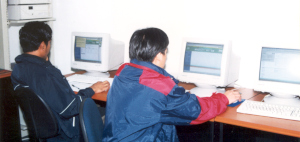 The solution was to integrate test engineering with technical support. This made it a requirement that all support people were “hands on” engineers. Staff spent their time split between support tasks (email, answering calls) and working in our test lab. The result was that out support people became much better, and had the ability to take problems from customers directly to a test environment for further analysis. It also ensured that we maintained a constant test mentality and capability. As we were providing 24×7 support, this extended our test abilities to also be able to run around the clock. Both technical support and test engineering benefited greatly from this integration.
The solution was to integrate test engineering with technical support. This made it a requirement that all support people were “hands on” engineers. Staff spent their time split between support tasks (email, answering calls) and working in our test lab. The result was that out support people became much better, and had the ability to take problems from customers directly to a test environment for further analysis. It also ensured that we maintained a constant test mentality and capability. As we were providing 24×7 support, this extended our test abilities to also be able to run around the clock. Both technical support and test engineering benefited greatly from this integration.
Technical Writing and Documentation
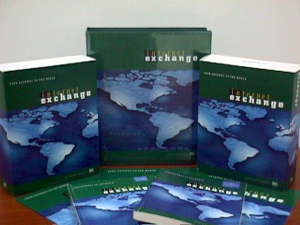 When we opened the Philippine office one of the hopes was that we could build a strong technical writing team. For all the benefits of being in Hong Kong, finding professional English language technical writers was not one of them. What we found with the writers we hired was similar to what we found with the technical support group. The highly technical nature of our products made it difficult to find people who could both understand the technology and write professionally.
When we opened the Philippine office one of the hopes was that we could build a strong technical writing team. For all the benefits of being in Hong Kong, finding professional English language technical writers was not one of them. What we found with the writers we hired was similar to what we found with the technical support group. The highly technical nature of our products made it difficult to find people who could both understand the technology and write professionally.
This put me back in the position where I had to do most of the writing for the company. While it was difficult getting people who could write good original content, we did have success in writing other material. This included white papers, and other marketing and promotional material. The combination of the writing staff, support and engineering groups provided invaluable assistance with copy editing and proofing of the many drafts. The archive site below contains copies of all IMA product documents.
IMA Product Documentation (archive)
Call Center
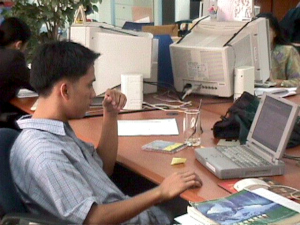 An integral part of our enterprise messaging solutions was the technical support that came with it. We ran a very successful 24×7 support group out of the Philippine office. Customers loved working with the newly integrated test engineering group. This allowed us to provide both quicker and better quality responses. The call center predated fast local Internet access and VoIP solutions were still a ways off. Instead we ran a Frame Relay circuit between our Philippine office and a Sunnyvale, California service provider. They provided 4 phone lines connected directly into our FRAD. On the local side we ran a Dialogic based PABX to connect the office extensions with both local phone and USA phone connections.
An integral part of our enterprise messaging solutions was the technical support that came with it. We ran a very successful 24×7 support group out of the Philippine office. Customers loved working with the newly integrated test engineering group. This allowed us to provide both quicker and better quality responses. The call center predated fast local Internet access and VoIP solutions were still a ways off. Instead we ran a Frame Relay circuit between our Philippine office and a Sunnyvale, California service provider. They provided 4 phone lines connected directly into our FRAD. On the local side we ran a Dialogic based PABX to connect the office extensions with both local phone and USA phone connections.
When we changed offices we leased out a full floor in a local office building, and proceeded to rip out all power and telco cabling. A full floor Online UPS with proper 3-wire circuits ran the office. This in turn connected to both the local electric provider and an emergency generator for a 100% available solution. In an environment famous for power problems we ended up with a setup that provided 100% up-time regardless of local power issues or weather.
